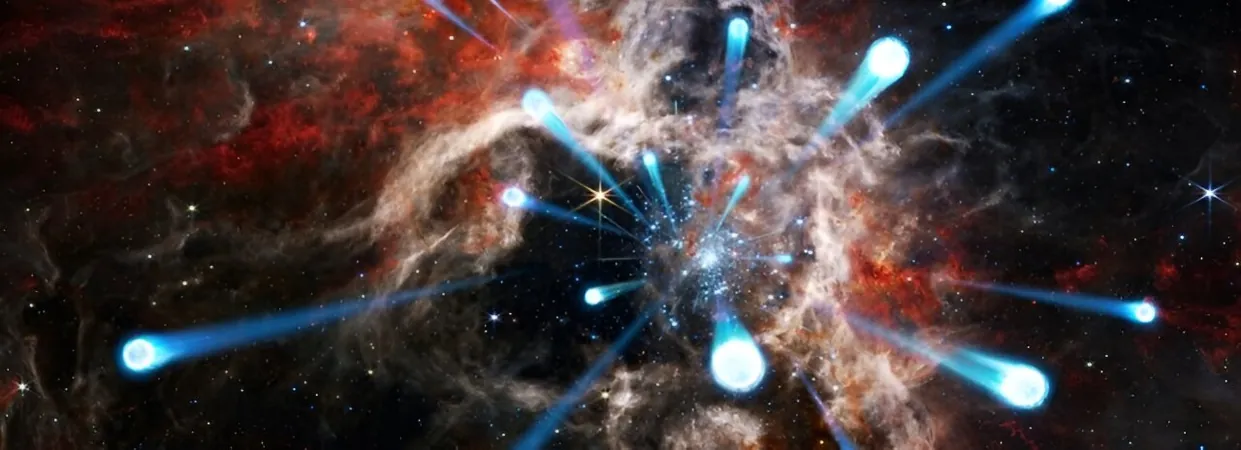
Breakthrough Discovery: Astronomers Uncover 55 High-Speed Stars Catapulted from R136 Star Cluster!
2024-10-09
Author: Benjamin
Breakthrough Discovery in Astronomy
Astronomers have made a groundbreaking discovery utilizing data from the European Space Agency's Gaia Space Telescope, identifying 55 high-speed stars that have been launched from the young star cluster R136, located in the Large Magellanic Cloud—a satellite galaxy of our Milky Way. This astonishing find magnifies the known population of "runaway stars" in this region tenfold, as detailed in a recent publication in Nature by a team of researchers led by UvA Ph.D. student Mitchel Stoop, including renowned scientist Simon Portegies Zwart from Leiden Observatory.
The Dynamics of R136
R136 serves as a natural laboratory for studying stellar dynamics. The formation of this star cluster, dating back just 1.8 million years, initiated a series of near-collisions among its densely packed, fast-moving stars, which ultimately led to their ejection from the cluster. The study revealed that nearly one-third of R136's most massive stars have been expelled in recent millions of years, traveling at astonishing speeds upwards of 100,000 kilometers per hour. These high-velocity stars can venture up to 1,000 light-years away from their origins before meeting their end in explosive supernovae, giving rise to neutron stars or black holes.
Distinct Episodes of Stellar Ejection
In an intriguing turn of events, the team discovered not one, but two distinct episodes of stellar ejection. The first incident coincided with the cluster's formation 1.8 million years ago, while the second episode occurred merely 200,000 years ago but exhibited a striking difference in characteristics. Stoop elaborates, "The runaway stars from the latter event are moving more slowly and are funneled in a preferred direction, contrasting sharply with the random dispersal seen in the initial ejection."
Potential Interactions with Other Clusters
Co-author Alex de Koter highlights a potential explanation for this second episode, suggesting that it may have been driven by the interaction of R136 with another star cluster discovered in 2012. This interaction could signify an impending merger of the two clusters in the future.
The Influence of Massive Stars
Massive stars like those in R136 shine exceptionally brightly—over a million times more luminous than our sun—and emit substantial ultraviolet radiation, ionizing the hydrogen gas in their vicinity. Although they live relatively short lives in astronomical terms (mere millions of years), they usually explode as supernovae in the star-forming regions where they originated. However, with the revelation that 55 stars have been expelled early on, the influence of these massive stars on galaxy structure and evolution is likely far greater than previously understood. There’s even speculation that runaway stars from the early universe played a significant role in the re-ionization of the cosmos.
Gaia's Role in the Discovery
The Gaia telescope has revolutionized our understanding of stellar dynamics by meticulously measuring the positions, distances, and velocities of over a billion stars from an orbit 1.5 million kilometers away from Earth. The successful identification of these stars in the massive cluster R136, situated 160,000 light-years from our home planet, underscores Gaia's impressive capabilities despite the vast distances involved.
Importance of Stellar Interactions
This discovery highlights the profound nature of celestial mechanics and the importance of young star clusters as catalysts in the cosmic dance of evolution. As the research team celebrates this monumental achievement, they emphasize the crucial need for ongoing exploration of stellar interactions, which may hold the keys to unlocking the universe's mysterious past.
Historical Context of Runaway Stars
In a historical context, it's worth noting that the concept of runaway stars was first hinted at by Dutch astronomer Adriaan Blaauw in 1946 during his doctoral research. Utilizing data from early space missions such as ESA's Hipparcos, Blaauw set the stage for future studies on the trajectory and dynamics of runaway stars, culminating in the modern capabilities afforded by the Gaia mission.
Conclusion and Future Exploration
Stay tuned for more cosmic revelations!









 Brasil (PT)
Brasil (PT)
 Canada (EN)
Canada (EN)
 Chile (ES)
Chile (ES)
 España (ES)
España (ES)
 France (FR)
France (FR)
 Hong Kong (EN)
Hong Kong (EN)
 Italia (IT)
Italia (IT)
 日本 (JA)
日本 (JA)
 Magyarország (HU)
Magyarország (HU)
 Norge (NO)
Norge (NO)
 Polska (PL)
Polska (PL)
 Schweiz (DE)
Schweiz (DE)
 Singapore (EN)
Singapore (EN)
 Sverige (SV)
Sverige (SV)
 Suomi (FI)
Suomi (FI)
 Türkiye (TR)
Türkiye (TR)